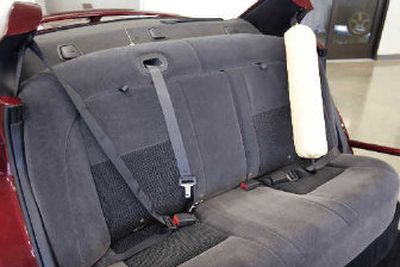Safety gets new look

DETROIT — Called the Kanagawa project, automakers in Japan are studying a system that alerts drivers to the presence of children in a busy urban neighborhood.
As part of the experiment, Nissan Motor Corp. is placing bracelets on young children that relay signals to vehicles in the area. Drivers passing through are told, “Children nearby, please be careful.”
The Nissan project, like others in the auto industry, reflect the increased focus on developing ways of preventing crashes and fatalities. From the stages of the North American International Auto Show, new “pre-crash” safety technologies are emerging that target the crucial milliseconds before a crash or help drivers avoid the crashes in the first place.
“As we go forward in the safety area, pre-crash technologies are the next big area,” said Robert Yakushi, Nissan’s director of product safety and environmental.
In the United States, more than 43,000 people die annually on roadways — the equivalent of an airplane crashing every day with nearly 120 people aboard — and fatality numbers have remained largely stagnant for the past two decades.
Safety officials have improved restraint systems such as seat belts and air bags to the point that many believe more research should be focused on the pre-crash systems that help tell the driver and the vehicle when a crash is imminent.
In addition to the basic restraints, most vehicles now have antilock brakes and automakers have been putting anti-rollover technology such as electronic stability control on vehicles in recent years. The government has proposed mandating ESC on all new vehicles by 2012.
“Safety is not a static concept and our approach to improving it cannot be static either,” said Transportation Secretary Mary Peters during a visit to the auto show on Monday.
Reflecting the advancements, Peters announced plans to upgrade the consumer crash test program to take into account ESC, lane departure warnings and other technologies.
Safety remains a competitive issue for manufacturers and a major selling point at dealerships. A recent poll conducted by AP-AOL Autos found that 21 percent of consumers wanted side air bags as an option, the most popular choice, followed by 20 percent seeking antilock brakes.
The telephone poll of 1,004 adults was conducted Dec. 19-21, 2006, and the margin of sampling error was plus or minus 3 percentage points.
In Detroit’s auto show, the interest in advanced safety measures was apparent.
Volvo Cars introduced an XC60 crossover concept with a radar system that monitors vehicles about 20 feet in front of the car. When a collision is likely, the technology helps the driver avoid a rear crash by automatically activating the car’s brakes.
Volvo, a division of Ford Motor Co., is expected to introduce the safety technology on vehicles in two years and the upgrades could help reduce whiplash injuries, said Fredrik Arp, Volvo’s president and chief executive.
DaimlerChrysler AG’s Mercedes-Benz division offers advanced safety features on its ultra luxury vehicles, the S-Class. One uses long-range and short-range radar to avoid crashes by automatically hitting the brakes if the driver fails to stop in time.
Another feature, called Night View Assist, uses infrared beams to detect roadway obstructions far beyond the headlights’ reach and transmits an image on the instrument panel.